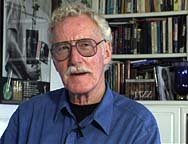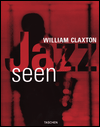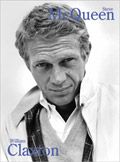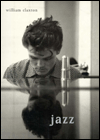|
William Claxton: Photographic Memory
by
Garrett White
Photography is a
form of memory. A century ago, the French novelist Emile Zola wrote,
"You cannot claim to have really seen anything until you have photographed
it." He might have said, you can't claim to have really remembered anything
until you've seen a photograph. A photographic image, a work of art
as a record of a moment in time, is the way we remember our world. Memory,
of course, is itself a work of art. And what we see in a photograph
is always a mix of what we bring to it - how we feel about the subject,
how we respond to what we see - and what the photographer has created
out of light and movement and place.
 The
pattern of a life can be captured in a photograph. Not the whole ineffable
life, to be sure, but something we recognize as essential. We know this
instinctively, even in the memory of an image, especially of someone
we love: a familiar gesture, a certain glance, a well-wrought pose,
a moment, gone forever, of expressive will and human emotion. The life
expressed in Photographic Memory is William Claxton's. In the
early 1950s, while still in school at UCLA, Claxton began photographing
musicians on the flourishing Los Angeles jazz scene. His subsequent
history in jazz is well known. While still a student, he founded the
record company Pacific Jazz with producer Richard Bock and went on to
photograph (and often design) hundreds of album covers. His quintessential
images of jazz musicians appeared in scores of magazines and have been
shown in galleries and museums around the world. The body of work he
created chronicles a whole trajectory of postwar American jazz, from
its early years to bebop, West Coast Cool, and the flowering of free-form
improvisation. When shooting in Los Angeles and San Francisco, he often
photographed his subjects outside, bringing an intimacy to his images
that said as much about his friendships with these artists as it did
about the California light. He brought this same fresh approach to his
photographs of musicians in New York, Chicago, New Orleans, and other
cities around the country. The
pattern of a life can be captured in a photograph. Not the whole ineffable
life, to be sure, but something we recognize as essential. We know this
instinctively, even in the memory of an image, especially of someone
we love: a familiar gesture, a certain glance, a well-wrought pose,
a moment, gone forever, of expressive will and human emotion. The life
expressed in Photographic Memory is William Claxton's. In the
early 1950s, while still in school at UCLA, Claxton began photographing
musicians on the flourishing Los Angeles jazz scene. His subsequent
history in jazz is well known. While still a student, he founded the
record company Pacific Jazz with producer Richard Bock and went on to
photograph (and often design) hundreds of album covers. His quintessential
images of jazz musicians appeared in scores of magazines and have been
shown in galleries and museums around the world. The body of work he
created chronicles a whole trajectory of postwar American jazz, from
its early years to bebop, West Coast Cool, and the flowering of free-form
improvisation. When shooting in Los Angeles and San Francisco, he often
photographed his subjects outside, bringing an intimacy to his images
that said as much about his friendships with these artists as it did
about the California light. He brought this same fresh approach to his
photographs of musicians in New York, Chicago, New Orleans, and other
cities around the country.
Less well known
is the fact that throughout his career Claxton has just as assiduously
photographed people from all walks of life, both the famous - writers,
actors, directors, composers, artists, and fashion designers - and the
family and friends to whom he has been closest. Often there has been
little distinction between the two. In a sense, he has always been a
kind of neighborhood photographer, though later his neighborhood became
the world. Many of the photographs shown in the gathering of pictures
featured here - whether shot in a recording studio, on a Hollywood sound
stage, or in the living rooms of his subjects - were taken within a
few miles of Claxton's home at the top of Benedict Canyon above Beverly
Hills.
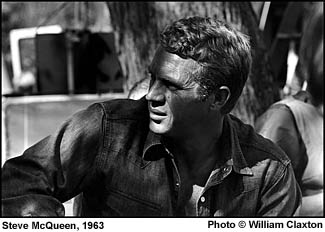 A
Pasadena kid who went to high school in Glendale, Claxton has been an
insider in the world of L.A. art and entertainment for most of his adult
life. He has always moved easily between jazz clubs, recording studios,
the art scene, film sets, and the homes of the artists who became his
friends. Above all, this work is about friendship. As a young man Claxton
gravitated toward jazz musicians because of his precocious love of their
music. That love was true enough to earn him lifelong friendships with
many of those he photographed. (After a gig on Central Avenue, while
still living with his parents, he brought Charlie Parker home for an
early-morning dinner, as good an example as there is about how to reconcile
life and art.) Later, he continued to be drawn to jazz musicians, I
believe, because as a rule they don't care about pretense. For one thing,
fakery interferes with the music. For another, they've most often been
on the outside of polite society. As a result, they are who they are,
take it or leave it. Style? It's all they've got. And if this book is
first and foremost about friendship, it is next about style. Although
genuinely too modest to admit it, Claxton is universally considered
as gracious, funny, elegant, and stylish a man as you are likely to
meet, and with enough charm and wit to have been at home in any Noel
Coward play. He has always admired these qualities in others, especially
in those who seem to have them effortlessly and in abundance, and it
shows in the photographs - in the beauty of Gloria Swanson shopping
with Claxton in an antique store, on the set with the eternally hip
Steve McQueen, or in the image of a dapper Vincent Price at home with
his renowned collection of art. A
Pasadena kid who went to high school in Glendale, Claxton has been an
insider in the world of L.A. art and entertainment for most of his adult
life. He has always moved easily between jazz clubs, recording studios,
the art scene, film sets, and the homes of the artists who became his
friends. Above all, this work is about friendship. As a young man Claxton
gravitated toward jazz musicians because of his precocious love of their
music. That love was true enough to earn him lifelong friendships with
many of those he photographed. (After a gig on Central Avenue, while
still living with his parents, he brought Charlie Parker home for an
early-morning dinner, as good an example as there is about how to reconcile
life and art.) Later, he continued to be drawn to jazz musicians, I
believe, because as a rule they don't care about pretense. For one thing,
fakery interferes with the music. For another, they've most often been
on the outside of polite society. As a result, they are who they are,
take it or leave it. Style? It's all they've got. And if this book is
first and foremost about friendship, it is next about style. Although
genuinely too modest to admit it, Claxton is universally considered
as gracious, funny, elegant, and stylish a man as you are likely to
meet, and with enough charm and wit to have been at home in any Noel
Coward play. He has always admired these qualities in others, especially
in those who seem to have them effortlessly and in abundance, and it
shows in the photographs - in the beauty of Gloria Swanson shopping
with Claxton in an antique store, on the set with the eternally hip
Steve McQueen, or in the image of a dapper Vincent Price at home with
his renowned collection of art.
Although best known
for his jazz photographs, Photographic Memory - a book-in-progress
planned for publication in fall 2001 - reveals Claxton as a versatile
artist whose subject is the human face and the human form. "The international
languages of jazz and photography need no special education or sophistication
to be enjoyed," he has said. "All I ask you to do is listen with your
eyes." It's a request that can be applied to all of his work. And if
we listen with our eyes - aware of the parallel between a photographer
with his camera and a musician with his "ax" - what we see in Photographic
Memory is the pattern of a life expressed, like that of any great
musician, in pursuit of the truest notes.
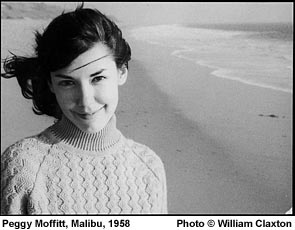 Key
to that life is the Peggy of these pages. Peggy Moffitt, Claxton's wife
of more than forty years, has been a pivotal influence in his life and
art. Their work together began with shooting album covers and continued
with the fashion designer Rudi Gernreich, Claxton as photographer, Moffitt
as model and muse to them both. Her reputation as a groundbreaking model
who contributed to the crafting of the images in which she appeared
does only partial justice to the depth of the lifelong collaboration
between the two. The love they have brought to their art is evident
here, and the memories offered in these photographs are shared between
them. More often than not, as you will see, they are our memories too. Key
to that life is the Peggy of these pages. Peggy Moffitt, Claxton's wife
of more than forty years, has been a pivotal influence in his life and
art. Their work together began with shooting album covers and continued
with the fashion designer Rudi Gernreich, Claxton as photographer, Moffitt
as model and muse to them both. Her reputation as a groundbreaking model
who contributed to the crafting of the images in which she appeared
does only partial justice to the depth of the lifelong collaboration
between the two. The love they have brought to their art is evident
here, and the memories offered in these photographs are shared between
them. More often than not, as you will see, they are our memories too.
Garrett White is a writer and producer
in a variety of media, from commercial and academic publications to
documentary film. Since January 1999 he has served as Director of Publications
for the Los Angeles County Museum of Art.
Enter
William Claxton's Photo Gallery
|

 The
pattern of a life can be captured in a photograph. Not the whole ineffable
life, to be sure, but something we recognize as essential. We know this
instinctively, even in the memory of an image, especially of someone
we love: a familiar gesture, a certain glance, a well-wrought pose,
a moment, gone forever, of expressive will and human emotion. The life
expressed in Photographic Memory is William Claxton's. In the
early 1950s, while still in school at UCLA, Claxton began photographing
musicians on the flourishing Los Angeles jazz scene. His subsequent
history in jazz is well known. While still a student, he founded the
record company Pacific Jazz with producer Richard Bock and went on to
photograph (and often design) hundreds of album covers. His quintessential
images of jazz musicians appeared in scores of magazines and have been
shown in galleries and museums around the world. The body of work he
created chronicles a whole trajectory of postwar American jazz, from
its early years to bebop, West Coast Cool, and the flowering of free-form
improvisation. When shooting in Los Angeles and San Francisco, he often
photographed his subjects outside, bringing an intimacy to his images
that said as much about his friendships with these artists as it did
about the California light. He brought this same fresh approach to his
photographs of musicians in New York, Chicago, New Orleans, and other
cities around the country.
The
pattern of a life can be captured in a photograph. Not the whole ineffable
life, to be sure, but something we recognize as essential. We know this
instinctively, even in the memory of an image, especially of someone
we love: a familiar gesture, a certain glance, a well-wrought pose,
a moment, gone forever, of expressive will and human emotion. The life
expressed in Photographic Memory is William Claxton's. In the
early 1950s, while still in school at UCLA, Claxton began photographing
musicians on the flourishing Los Angeles jazz scene. His subsequent
history in jazz is well known. While still a student, he founded the
record company Pacific Jazz with producer Richard Bock and went on to
photograph (and often design) hundreds of album covers. His quintessential
images of jazz musicians appeared in scores of magazines and have been
shown in galleries and museums around the world. The body of work he
created chronicles a whole trajectory of postwar American jazz, from
its early years to bebop, West Coast Cool, and the flowering of free-form
improvisation. When shooting in Los Angeles and San Francisco, he often
photographed his subjects outside, bringing an intimacy to his images
that said as much about his friendships with these artists as it did
about the California light. He brought this same fresh approach to his
photographs of musicians in New York, Chicago, New Orleans, and other
cities around the country. A
Pasadena kid who went to high school in Glendale, Claxton has been an
insider in the world of L.A. art and entertainment for most of his adult
life. He has always moved easily between jazz clubs, recording studios,
the art scene, film sets, and the homes of the artists who became his
friends. Above all, this work is about friendship. As a young man Claxton
gravitated toward jazz musicians because of his precocious love of their
music. That love was true enough to earn him lifelong friendships with
many of those he photographed. (After a gig on Central Avenue, while
still living with his parents, he brought Charlie Parker home for an
early-morning dinner, as good an example as there is about how to reconcile
life and art.) Later, he continued to be drawn to jazz musicians, I
believe, because as a rule they don't care about pretense. For one thing,
fakery interferes with the music. For another, they've most often been
on the outside of polite society. As a result, they are who they are,
take it or leave it. Style? It's all they've got. And if this book is
first and foremost about friendship, it is next about style. Although
genuinely too modest to admit it, Claxton is universally considered
as gracious, funny, elegant, and stylish a man as you are likely to
meet, and with enough charm and wit to have been at home in any Noel
Coward play. He has always admired these qualities in others, especially
in those who seem to have them effortlessly and in abundance, and it
shows in the photographs - in the beauty of Gloria Swanson shopping
with Claxton in an antique store, on the set with the eternally hip
Steve McQueen, or in the image of a dapper Vincent Price at home with
his renowned collection of art.
A
Pasadena kid who went to high school in Glendale, Claxton has been an
insider in the world of L.A. art and entertainment for most of his adult
life. He has always moved easily between jazz clubs, recording studios,
the art scene, film sets, and the homes of the artists who became his
friends. Above all, this work is about friendship. As a young man Claxton
gravitated toward jazz musicians because of his precocious love of their
music. That love was true enough to earn him lifelong friendships with
many of those he photographed. (After a gig on Central Avenue, while
still living with his parents, he brought Charlie Parker home for an
early-morning dinner, as good an example as there is about how to reconcile
life and art.) Later, he continued to be drawn to jazz musicians, I
believe, because as a rule they don't care about pretense. For one thing,
fakery interferes with the music. For another, they've most often been
on the outside of polite society. As a result, they are who they are,
take it or leave it. Style? It's all they've got. And if this book is
first and foremost about friendship, it is next about style. Although
genuinely too modest to admit it, Claxton is universally considered
as gracious, funny, elegant, and stylish a man as you are likely to
meet, and with enough charm and wit to have been at home in any Noel
Coward play. He has always admired these qualities in others, especially
in those who seem to have them effortlessly and in abundance, and it
shows in the photographs - in the beauty of Gloria Swanson shopping
with Claxton in an antique store, on the set with the eternally hip
Steve McQueen, or in the image of a dapper Vincent Price at home with
his renowned collection of art. Key
to that life is the Peggy of these pages. Peggy Moffitt, Claxton's wife
of more than forty years, has been a pivotal influence in his life and
art. Their work together began with shooting album covers and continued
with the fashion designer Rudi Gernreich, Claxton as photographer, Moffitt
as model and muse to them both. Her reputation as a groundbreaking model
who contributed to the crafting of the images in which she appeared
does only partial justice to the depth of the lifelong collaboration
between the two. The love they have brought to their art is evident
here, and the memories offered in these photographs are shared between
them. More often than not, as you will see, they are our memories too.
Key
to that life is the Peggy of these pages. Peggy Moffitt, Claxton's wife
of more than forty years, has been a pivotal influence in his life and
art. Their work together began with shooting album covers and continued
with the fashion designer Rudi Gernreich, Claxton as photographer, Moffitt
as model and muse to them both. Her reputation as a groundbreaking model
who contributed to the crafting of the images in which she appeared
does only partial justice to the depth of the lifelong collaboration
between the two. The love they have brought to their art is evident
here, and the memories offered in these photographs are shared between
them. More often than not, as you will see, they are our memories too.